In my opinion, self-defense involves a whole host of things that do not involve fighting at all. Some would argue, including me, that the ultimate self defense is to not engage in fighting.
So to me, what sets self defense apart from sport/fighting/traditional martial arts are:
- An emphasis on situational awareness, where you identify potential threats and avoid them before there's an issue.
- Evasion - knowing how to get out of an area once you identify a threat without calling attention to yourself.
- De-escalation - if you can't avoid a situation, talk your way out of it.
- Mindset - what is the predator mindset? What do they want? What are they looking for in a target? How do they distract you? Where might they hide to gain an advantage? What are some pre-contact cues? Under what circumstances do I strike first?
So I should be aware of threats, avoiding threats, evading threats, and talking my way out of threats. This should be successful the vast majority of the time.
If ALL those things fail, now I need to fight. In that case, I prefer gross (vs. fine) motor movements as my brain will be flooded with adrenaline and I'll have a very difficult time remembering any complex techniques. One of my favorite combinations I learned from a Kelly McCann video where you gouge/claw with one hand, then hit them with a hammerfist, then claw/rake/hold with one hand and continue beating them down with the hammerfist. I think McCann refers to it as a "rake and cycle" technique. And if I can place a tool I'm carrying or improvised weapon in the grip of that hammerfist, all the better. It won't be pretty, and it may not work as expected, but you keep going until you can get away or stop the threat.
When I train in this kind of "fighting," it's called a "scramble." I don't know what my partner is going to do, and therefore I don't know what I'm going to do,. I have to figure it out and deal with whatever the situation is until I can stop the threat or get away. We don't go hard with gear, but that may be something we do more of in the future. I've had a bloody lip and nose and host of bruises from scrambling, so you do learn to take some punishment - which is a whole other skill.
After the confrontation, you have to be ready to talk to the police. You may get involved in a lawsuit. Or you may have some guys looking for you out for revenge (another reason to avoid conflict to begin with). Did they get a look at my vehicle when I got away? Are they local guys I might see again? Do I need to avoid places I didn't need to avoid before? Do I have proper home security just in case? There's a whole host of other issues there.

